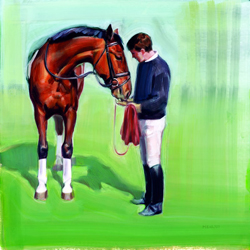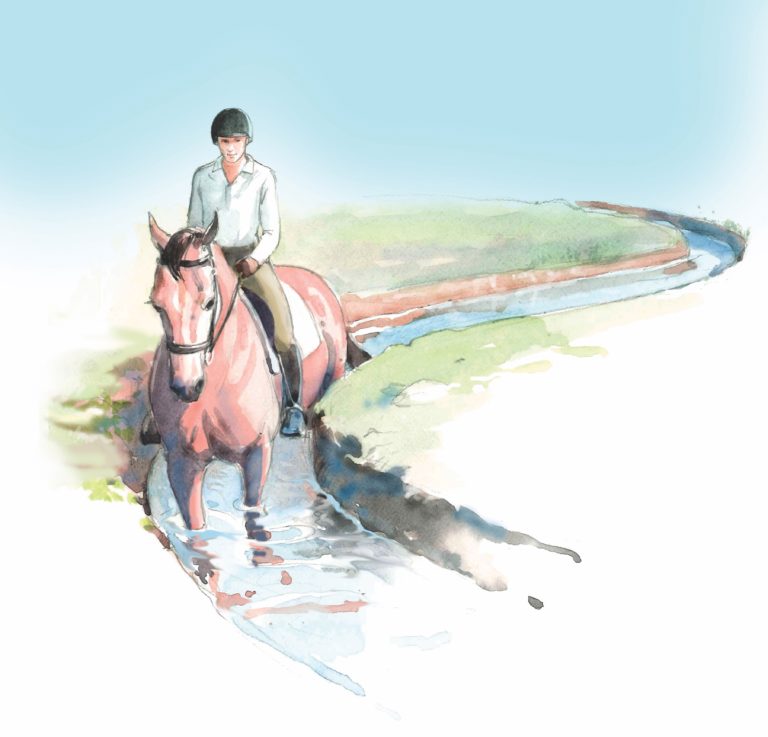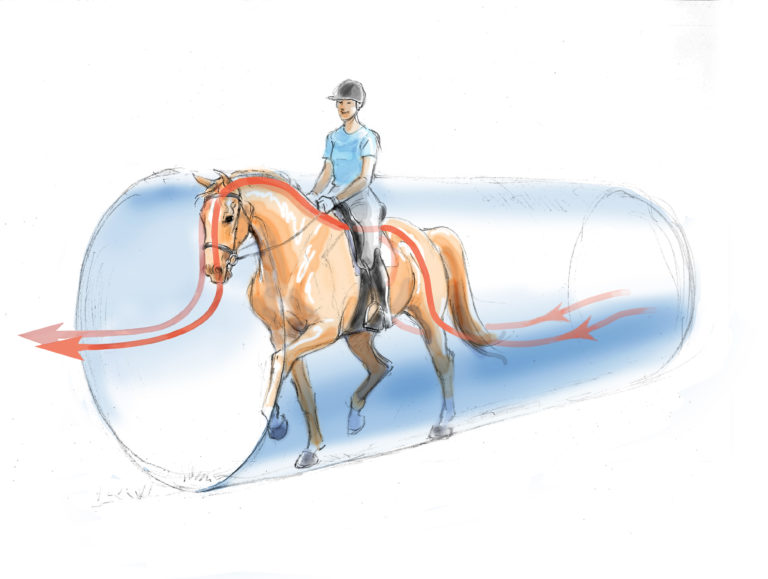
Understanding the personality of your horse, coupled with knowledge of your own temperament and skill level, gives you the best chance for success in your daily rides. My goal in this series of articles is to share insights that may help you better understand your horse, yourself and other people you interact with. In parts one and two, I described the four basic horse personality types as I define them–Social, Aloof, Challenging and Fearful. In this part, Gail Rodecker, a professional Myers-Briggs consultant and administrator, explains how human personality is typed and how we can use this information in choosing and training dressage horses. In the next and last part of this series, I’ll give you examples of good and not-so-good personality matches and explain how this information can also help you find a compatible instructor. –Yvonne Barteau
Wouldn’t it be wonderful if we had better insight into what makes each of us tick–why some of us thrive in the competition ring while others cringe at the thought of ever riding down that centerline? How can one rider absorb and make use of the harsh words of a tough clinician or judge while the next wilts under such pressure? Why does a particular horse frustrate one person and inspire another? The answers to these questions lie in our innate personality preferences, which have a tangible influence on all aspects of our lives. How we communicate, manage our relationships and ride and train our horses can often be traced back to our individual and unique personalities. What follows is a brief discourse on the different human personality types. Knowing and understanding ourselves and others can open a new world of clarity and appreciation of who we are and why we think and act the way we do. This information gives us a better understanding of how to communicate with the people and horses in our lives.
The Different Personality Types
Personality Type theory was developed in the 1920s by Swiss psychiatrist Carl Jung and the mother/daughter team of Katherine Briggs and Isabel Briggs-Myers. Since then, the Myers-Briggs Type Indicator? (MBTI), has become the most widely used and respected tool for facilitating communication among individuals and within organizations. About 2 million people in the United States take the MBTI each year.
Many of you have just begun to understand the personality types of horses in Yvonne’s series in previous articles. Now, I will add to that by describing the basic eight possible preferences that comprise a human’s personality type. According to the MBTI, there are four different components to our personalities. As you read this, remember that all types are needed in a society to accomplish the different work that needs to be done. No type is more desirable than any other, since each has strengths and weaknesses. The MBTI describes personalities with a four-letter acronym, such as ESTJ or INFP. Briefly, here are what the letters indicate:
Extravert/Introvert. The first letter describes how we are energized through people, action and events as extraverts or internally through thoughts, ideas and concepts as introverts. Extraverts will often express themselves easily and readily. They form their thoughts as they speak them. Introverts want and need time to reflect or mull over ideas before they present them. Being alone or quiet for too long is draining for an extravert. Too much interaction, particularly of a superficial nature or in large groups is wearying for an introvert.
In a riding/training situation, it is most helpful for both types to be aware of this significant difference. The extraverted trainer working with an extraverted rider may both leave a lesson a bit frustrated, feeling they had to fight for air-time. The introverted trainer and rider may leave their lesson with too much unsaid. When participants are cognizant of the extravert/introvert differences, extraverted trainers will know to give ample opportunity for their introverted students to speak up and voice concerns, maybe even asking pointed questions. Introverted instructors benefit from knowing that an extravert often must talk through the learning process in order to best understand and make use of the information.
Sensing/Intuition. The next letter indicates how we learn. A sensing type takes in information through the five senses in a factual, literal way and learns best when the information is presented in a straightforward, realistic manner. Intuitive types learn best when presented with concepts and general principles first. They become bored with too much repetition or routine.
It is a tremendous advantage for a trainer/rider pair to understand this difference. Imagine the frustration of the intuitive-type rider taking lessons from a sensing-type trainer, who makes every effort to organize her lessons in a clear, factual and sequential manner. Both try mightily, but both finish the lesson exasperated; the intuitive rider cannot concentrate on, nor is she interested in, so many details, and the sensing trainer cannot understand why, no matter how many times she explains something, the rider just doesn’t get it!
The sensing trainer must understand that with an intuitive rider she needs to first explain the overall concept of the lesson, throwing in only the essentials details as needed and keeping the big picture in mind. She might then be able to tap into her rider’s best learning mode and substantially hasten the learning process. Alternately, the sensing rider will derive the most from a lesson that is delivered with clear and precise instructions, addressing what the current issues are and also encouraging her to look to the future.

Thinking/Feeling. The next facet of each person’s type involves how we make our decisions. Thinking types and feeling types make their decisions in fundamentally disparate ways, because their decisions are based on a completely different set of criteria. This difference impacts the hundreds of decisions and choices made each day. Conflict arising from these preferences is the primary reason for the hurt feelings, bruised egos and the sometimes-profound feelings of misunderstanding that we experience.
The thinking type considers objective information from a detached and analytical perspective that will lead to logical conclusions. On the other hand, feeling types make decisions in a more personal way, first gauging how they, or those involved, will be impacted as they strive to make the decision feel right. Thinkers are convinced by logic. Feelers are convinced by harmony. But, make no mistake, thinkers feel and feelers think!
Our preference for thinking or feeling also has a significant impact on our learning process. An important concept to understand in all of our relationships is that feeling types, whether children or adults, need to know that they are valued and appreciated before much learning can take place. A thinking type will best learn from someone whom she respects for her competence and mastery of the subject.
As we develop in maturity and self-awareness, it is extremely valuable for thinking types to learn to appraise and recognize the impact of their sometimes-direct and forceful interactions on feeling types and to soften their tone as needed. It is just as valuable for feeling types to realize that not everything needs to be taken so personally and that it can actually be quite liberating to detach from the feelings the situation provokes.
Thinking-type dressage trainers will want to make a special effort to establish a warm connection with their feeling-type riders and to take care that their approach does not seem harsh or distant. Similarly, feeling-type instructors will want to ensure that their training methods are credible, direct and consistent for a thinking-type rider.
Judging/Perceiving. The last component of our personality type concerns how we organize the world around us. Those who need a sense of order and structure in their lives and want matters settled and decided are called judging types (not to be confused with being judgmental). They have a more rigid view of time, usually being very concerned with planning both their projects and their play, so tardiness and wasting time will never be a problem for them. Judging types are usually considered decisive and, at times, even opinionated.
People who have a preference for perceiving (not to be confused with being perceptive) are more comfortable with the process of gathering information, rather than coming to any conclusion. They tend to live “in the moment” with a more flexible and open-minded view of their world. Because they see time as a more elastic, endless resource, planning ahead and making firm commitments seems to be an unnecessary, if not downright distasteful, task.
When the atmosphere and structure of a training facility is rather loose and unstructured, it is the perceiving types who are bothered the least by this, since they seem able to “go with the flow.” But the judging types will find this seeming disorganization distracting and unsettling. Hence, it will be the judging types who will want to keep their perceiving counterparts focused and on task, lest their more playful temperaments get in the way of their eventual goals. Perceiving types, in turn, can help the judging types to lighten up and relax their sometimes overly strict standards.
While we can often see ourselves in each of these eight preferences, what establishes our type is the frequency and innate preference for each of these mental functions, much like the preference for using your right or left hand. It is the combination of our four preferences that provides the fullest and richest picture of our psychological type. Determining your personality type from this condensed review would be difficult. So, I recommend taking the MBTI and learning about your type. It can be life changing (see sidebar “Taking the MBTI”).
Ideally, as we age and mature, we begin to see the value of tapping into our own opposite preferences. For example, judging types can learn to relax the rules a bit. Thinking types can discover that not all decisions must to be logical to be right. If a person can tolerate the mild discomfort of a serious self-examination and can explore new directions of growth, the rewards will be immense.
Personality Type and Riding
Our personality type also influences how we shop for horses, how we ride and train our horses and how we relate to our equine partners. There are, of course, many factors that shape our personalities and our interactions with horses, such as environment, education, intelligence and life experience. But there are many characteristics common to each type that influence our training style and compatibility with horses.
The following examples have been made with the assumption that many of us ride and train our horses largely alone or with only occasional help, such as a weekly or monthly lesson from a local trainer. Riders under constant supervision by a competent trainer can moderate natural tendencies of the individual types that hamper progress. For the rest of us more independent riders, we would be wise to key in on our own strengths and challenges in order to optimize our chances for a successful riding career.
In selecting a horse, it is easy for feeling types to choose with their hearts rather than to face the hard facts. They may be prone to buying the neediest of creatures rather than the most suitable horse, reasoning that all the horse needs is a little more tender loving care. They are the least able to detach themselves and evaluate a horse critically and the most likely to attach themselves emotionally to a horse, whether it is the right horse or not.
When riding, feeling types may shy away from a needed dispute with the horse, thus allowing him to have the upper hand all too often, and we all know where that leads. Also, in their reluctance to deliver a one-time sharp aid, they may deliver numerous, less effective aids, thus becoming “naggers.” However, feeling types are more in tune to what the horse is telling them and do not have an unalterable agenda of work that must be accomplished, regardless of what the horse can do.
Thinking types, who naturally face challenges with a more confident attitude, may consider taking on a horse that is beyond their particular riding capabilities in terms of behavior, size or trainability. They assume they can fix just about anything. It may not be long before they realize that they are in way over their heads. In their urgency to decide and fix now, they often fail to patiently take in enough information to embark on the most appropriate course. However, thinking types will take the inevitable setbacks or hiccups in their training journey as just that, a hiccup, and easily move on.

Sensing types will be acutely observant of the actual characteristics of a horse and his current training and behavior but may fail to see the potential or what “could be,” thereby passing up a golden opportunity. Because of their sometimes narrow focus, they may jeopardize their success by getting so immersed in a particular training issue that they fail to recognize the solution. If sensing types accept the fact that each glitch in their riding program will not lead to complete ruination of their horses, or themselves as riders, it will help set them back on a forward course. Because they are more naturally able to follow directions and lesson plans as explicitly given, their progress may be more consistent and have fewer holes.
Intuitive types, with their ability to see “what could be” better than “what is now,” may overlook the obvious and real issues a particular horse or horse/ rider combination may bring. Their natural idealism combined with their tendency to focus on the overall impression, rather than the details, may make their choices seem impractical. But, because of their optimistic nature, intuitive types–particularly intuitive-feeling types–can be quite adept at convincing themselves that their horses are coming along much better than they actually are. But, because of their ability to see a better tomorrow, the intuitive type is less likely to get bogged down.
Hence, finding your own personality type makes you aware of your tendencies and allows you to work with them. I am an ISFJ, an Introvert-Sensing-Feeling-Judging type. I don’t enjoy a daily diet of conflicts. And, since I ride mostly on my own with only occasional trips to my trainer, a challenging type horse was out of the question. As an introvert, I do not need a social horse and would have been happy enough with an aloof horse. But I chose a passive, social/aloof type, which has turned out to be a perfect match for me. He is a rather compliant fellow, and I love his social antics.
The observation by some dressage masters that learning to ride a horse takes more than one lifetime is undeniably true. But, as riders and trainers, we could make remarkable strides in accelerating this process if we paid more attention to the strengths and blind spots of our own individual type. If we coupled this with awareness of type in horses, we would have one more invaluable tool to help us navigate down the never-ending path that is dressage.
TAKING THE MBTI
The Myers-Briggs Type Indicator is not a test. You simply answer questions on a multiple-choice questionnaire. There are no right or wrong answers. Then the test is analyzed, and you receive detailed information about your type and how to make the most of your new understanding. Learn more about the MBTI at the Myers & Briggs Foundation website, myersbriggs.org, and Gail Rodecker’s website, TypeMeInc.com.
Gail Rodecker is a qualified Myers-Briggs Consultant (TypeMeInc.com). A former teacher, she now uses personality type to work with families, engaged couples and athletes/equestrians. She rides and competes her dressage horse, Lexington, at the FEI levels and lives in Fishers, Ind., with her husband and four children.
Yvonne Barteau is a U.S. Dressage Federation gold medalist. She and her husband, Kim, run KYB Dressage at Indian Hills Training Center in Gilberts, Ill. Her book on horse personalities, Ride the Right Horse, is published by Storey Books and available from HorseBooksEtc.com or by calling 800-952-5813.
This article was originally published in the November 2007 issue of Dressage Today magazine. To order back issues, call 301-977-3900.











